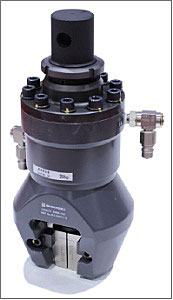Hydraulic Non-Shift Wedge Grips

Features:
- Applicable for testing a wide variety of materials, including metals, plastics, lumber, and composites
- Grips with maximum capacity up to 250 kN (55,000 lbf)
- To minimize specimen slippage, a constant clamping force is applied by hydraulic action
- Grip operator switch box enables one-touch chucking of specimens
- Compatible with a comprehensive selection of grip faces for testing rods, wires, materials with high hardness, and composite materials
Relevant Materials:
Plastics, Metals, Lumber, Composites
Relevant Specimens:
Plates, Rods, Wires
Hydraulic non-shift wedge grips combine the benefits of a strong, consistent clamping force with an open-front, wedge design and are ideal for tensile testing plastics, metals, lumber, and composites.
Grip kits include upper and lower grips, file-teeth grip faces for flat specimens, an initial load prevention unit, and a hydraulic unit. The hydraulic unit comes with a grip operator switch box, uses an AC 3-phase 200 V, 2.5 W power source, has a maximum pressure of 21 MPa (214 kg/cm2, 3,046 psi), and requires cooling water, a supply of 10 L/min.
The initial test force prevention unit removes the initial force as it is created during clamping of the specimen. It is necessary for hydraulic non-shift wedge grips because the clamping force is strong.
When ordering, grip kits should be matched to both the maximum capacity of the universal tester and the maximum capacity of the grips.
Additional grip faces, such as for rods, wires, materials with high hardness, and composite materials, can be found in the document on Grip Faces for Hydraulic Non-Shift Wedge Grips.
News / Events
-
AUTOGRAGH AGS-X2 Series has been released
The Shimadzu AUTOGRAPH AGS-X2 series provides superior performance and practical testing solutions for a wide array of applications. Offering high-level control and intuitive operation, the AGS-X2 series sets a new standard for strength evaluations while providing the utmost in safety considerations in a modern, stylish design.
-
AUTOGRAGH AGS-V Series has been released
Shimadzu Corporation released the Autograph AGS-V Series precision universal testing machine. In this series, the range over which the force measurement accuracy is guaranteed has been increased by a factor of two compared with existing machines. As a result of this new function, the work required to change force measurement sensors and accessories required for measurement can be reduced.
-
High-Speed Video Camera HyperVision HPV-X3 has been released
Recording speed of 20 million frames/second, the highest in its class provides larger, clearer, high-sensitivity recording. HPV-X3 is equipped with a synchronized recording function and high-level analytical capabilities that accommodate a variety of software programs.
-
New Video: AUTOGRAPH AGX-V2 Voice Operation Device XV-Talk
We will introduce how XV-Talk, the world's first voice control device installed in Shimadzu's latest tensile tester AGX-V2, can be used in various scenarios.
-
New Video: AUTOGRAPH AGX-V2 Operation Control Panel Stand-alone test feature
We will introduce a new feature of Shimadzu's latest tensile tester, AGX-V2, a stand-alone testing function using a large color LCD touch panel.
-
New Autograph AGX-V2 Series Precision Universal Testing Machines
The World’s First Testing Machines Equipped with a Voice Operation Device


